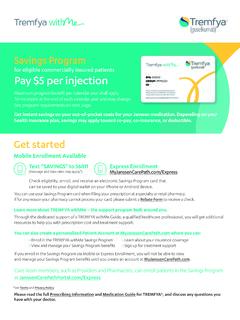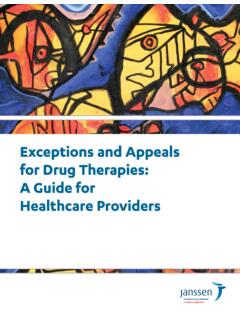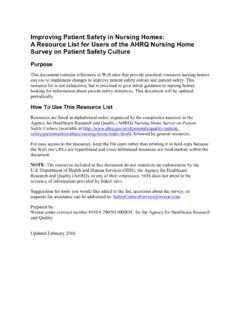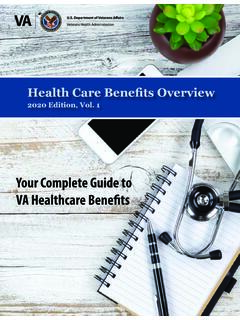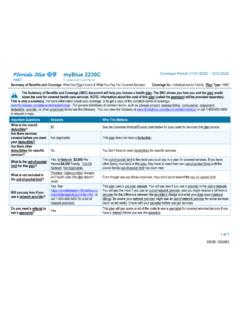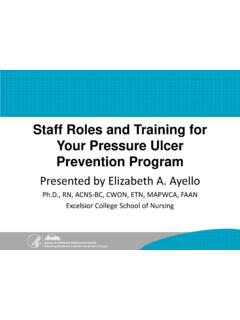Transcription of Your 2021 Medicare Resource Guide Explaining the …
1 Your 2021 Medicare Resource GuideExplaining the different parts of MedicareThis booklet is meant to help explain how Medicare may cover your care , including medications you may need. We hope you will find it helpful. 2AN INTRODUCTION TO Medicare 3 Medicare PART A 6 Medicare PART B 8 Medicare PART D (Prescription Drugs) 12 Medicare ADVANTAGE (Part C) 14 MEDIGAP ( Medicare Supplement) 10 DRUG COVERAGE and COMPARING COSTS 16 TALKING TO YOUR DOCTOR 20 GLOSSARY OF COMMON terms 22 RESOURCES 23 OTHER SOURCES OF SUPPORT 24 Table of Contents3An Introduction to MedicareMedicare is a federal system of health insurance for people over 65 years of age, certain younger people with disabilities, and people of any age with End Stage Renal Disease or Amyotrophic Lateral Sclerosis (ALS). The details of Medicare can be complicated, but understanding some basic facts can help you start down the path to matching Medicare with your healthcare needs.
2 Fact #1 Medicare has 4 Parts We tend to think about Medicare as one big insurance plan, but it is actually made up of 4 different parts that each provide certain types of coverage:Part A Hospital Insurance Helps cover inpatient care in hospitals and skilled nursing facilities, hospice, and certain home health servicesPart B Medical Insurance Helps cover doctors and other providers services, including some drugs administered by your doctor, outpatient care , durable medical equipment, and certain home health servicesPart C Medicare Advantage (MA) MA is an option to get Medicare Part A and Part B benefits through private health plans; some MA plans provide extra benefits for extra cost; most MA plans also provide prescription drug coverage under terms similar to Part DPart D Prescription Drugs Helps cover the cost of prescription drugsTogether the Parts of Medicare cover a large amount of healthcare needs but they do not cover everything.
3 Some of the things not covered by Part A and Part B (together referred to as Original Medicare ) include: dental care , certain hearing tests, care when you are traveling outside of the United States, eye care , and long-term care . Medicare Advantage (Part C) plans may cover some of these services, but if they include such extras, they may charge a higher premium. Fact #2 You Have Choices About Your Medicare CoverageThere are two main ways to get your Medicare coverage: Original Medicare and Medicare Advantage. The chart on the next page shows the difference between the two. There are also options for adding prescription drug coverage (Part D) and Medicare Supplement Insurance (Medigap). As your healthcare needs change over time, remember that you can review and change your coverage selections at least once a year. continued 4 Adapted from: Medicare & You 2021 (September, 2020).
4 Available in English, Spanish, and large print format at: Accessed October 8, #3 There are Costs for Medicare Coverage Understanding how Medicare benefits work may be the first step when considering your coverage choices, but understanding what the different options will cost you may be just as helps with the cost of your care but does not pay for all of it. It is expected that you will pay a portion, also referred to as cost-sharing. Depending on your healthcare needs, certain coverage combinations may be less costly to you than others. Medicare Cost-sharing1-3 TermWhat it isHow it works in MedicarePremiumA fixed amount that you have to pay to participate in a plan, usually a monthly payment Medicare Part A is usually premium-free Medicare Part B standard and income-adjusted premiums are published each year Medicare Advantage premiums vary by plan Medicare Part D premiums vary by planDeductibleA preset, fixed amount that you are required to pay before insurance starts to pay Medicare Part A standard deductible is published each year; applies to inpatient hospital stays (benefit periods) Medicare Part B standard deductible is published each year; applies to Part B covered services Medicare Advantage deductibles vary by plan Medicare Part D deductibles vary by plan.
5 Some do not charge a deductibleOriginal Medicare1 How do you want to get your coverage?Choose Part A (Hospital Insurance) and Part B (Medical Insurance)2 Do you need to add coverage for prescription drugs?Choose Part D (Prescription Drug Coverage)3 Do you need a supplement?Choose Medicare Supplement Insurance (Medigap) Medicare Advantage1 How do you want to get your coverage?Choose Part C (combines Part A, Part B, and often Part D)2 Do you need to add coverage for prescription drugs?Only if your MA plan does not provide prescription drug coverage should you enroll separately in Part DIf you join a Medicare Advantage Plan, you cannot buy or use a Medicare Supplement Insurance (Medigap) plancontinued 5 TermWhat it isHow it works in MedicareCo-payment( co-pay )A preset, fixed amount that you are required to pay for each service or product Medicare Part A standard co-payments are published each year; they apply to inpatient hospital and skilled nursing facility days Medicare Advantage Plans commonly charge co-pays; the amount and how they apply vary by plan Medicare Part D co-pays vary by planCo-insuranceAn amount (usually a percentage) you pay as your share of the cost for services after you pay any deductibles Medicare Part B generally pays 80% and you pay 20% co-insurance.
6 The percentage can vary by service Medicare Advantage Plans may charge co-insurance; the percentage and how it applies varies by plan Medicare Part D co-insurance varies by plan1 Some Medigap plans can help pay deductibles, co-insurance, and co-payment amounts for Medicare Part A and Part B. Medigap cannot be used to cover costs for Medicare Part C or Medicare Part D. Premiums for Medigap policies vary by plan and may even vary between insurance companies for the same level of benefits. 2 Medicare Advantage Plans cap the yearly amount you can spend on cost-sharing by setting out-of-pocket limits. The amount varies by plan. Original Medicare does not have out-of-pocket limits for Medicare Part D plans are modeled on a standard benefit that includes an initial coverage period, a coverage gap, and a catastrophic coverage period; specific cost-sharing requirements vary by #4 Help Is AvailableThere is help available to pay for many of the costs that Medicare does not cover.
7 You may be eligible if you have low income and limited resources. There is no cost or penalty if you later find that you do not meet the requirements so if you think you might qualify, go ahead and to Help With Medicare Costs* Medicaid Helps pay costs not covered by MedicareMay provide some additional benefits not covered by Original MedicareMedicare Savings ProgramsHelp pay for Medicare Part A and Part B costsPremiums; other cost-sharing like deductibles, co-payments, and co-insuranceExtra Help(Low-Income Subsidy)Helps pay for Medicare Prescription Drug Plan (Part D) costsPremium, deductible, co-insurance, co-payments, coverage gap* There may be other programs available to you, including State Pharmacy Assistance Programs and Patient Assistance Programs offered by drug More InformationYour State Medical Assistance (Medicaid) office: or call 1-800- Medicare (1-800-633-4227) to get the phone number for your state office; TTY users: 1-877-486-2048 Social Security or call 1-800-772-1213; TTY users: 1-800-325-07786 Medicare Part A Medicare Part A is also called Hospital Insurance.
8 It helps cover inpatient care in hospitals and skilled nursing facilities (SNFs), and provides benefits for end-of-life care in hospice. Medicare Part A does not pay all of the costs. In general, you must meet a deductible for each hospital stay, before Medicare begins to pay its share. For hospital stays beyond a certain number of days, you will then pay a daily co-payment. If you have Medicare supplement insurance (Medigap), it may help pay the deductible and co-payment Medicare Part A Does* Helps cover inpatient hospital care Helps cover qualified stays in an SNF Helps cover certain home health services and hospice services * Medicare Part A does not cover doctor services you get while in the hospital or SNF. Doctors services are covered under Medicare Part B. Some Important Points to Know About Medicare Part A:1. Medicare Part A (Hospital Insurance) along with Medicare Part B (Medical Insurance) is known as Original Medicare .
9 2. Medicare Part A is premium free if you or your spouse paid into Social Security for at least 40 quarters. If you are not eligible for premium-free Part A, you can buy Some people get Part A automatically and some will need to sign up for it. To avoid coverage delays, the best time to enroll is within the 3 months before your 65th Medicare Part A covers drugs you receive during an inpatient hospital stay or qualified SNF stay, and drugs for pain relief and symptom management in 7 Things to Consider About Medicare Part A As you near Medicare eligibility, review your current and expected health needs and compare them to the services covered under Medicare Part A. You may also want to compare Original Medicare (Part A and Part B) coverage with Medicare Advantage (Part C) plans to find the best fit for you. If you are already enrolled in Medicare , you have a chance to review and change your coverage each year during the annual Medicare Open Enrollment Period (October 15 to December 7).
10 See A Quick Look at Medicare and Understanding Medicare Enrollment Periods on Resources page you choose Original Medicare , consider how you will pay for the costs that Medicare does not cover. You may decide to pay the out-of-pocket expenses (deductible and co-insurance) yourself or you may choose to purchase Medigap. See Medicare Supplement Insurance: Getting Started on Resources page you have limited income, resources, or assets, and are having trouble paying healthcare costs, there is help. Medicaid and the Medicare Savings Programs may help pay premiums and costs not covered by Original Medicare . There is no penalty or fee to apply, even if you don t qualify for assistance. See Get Help With Your Medicare Costs on Resources page 23, or contact Social Security or Medicare you need help or more information, visit or call 1-800- Medicare (1-800-633-4227); TTY users: 1-877-486-20488 Medicare Part B Medicare Part B is also called Medical Insurance.
